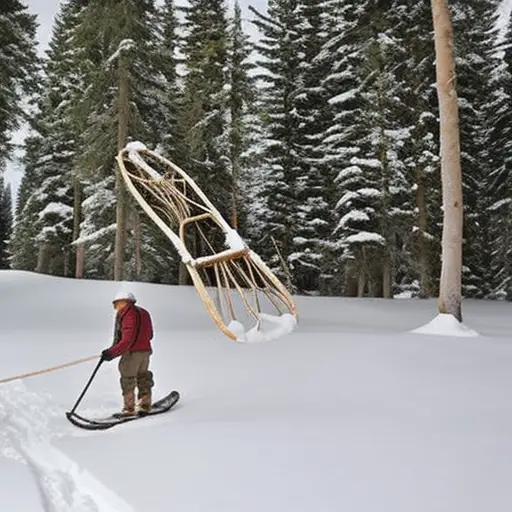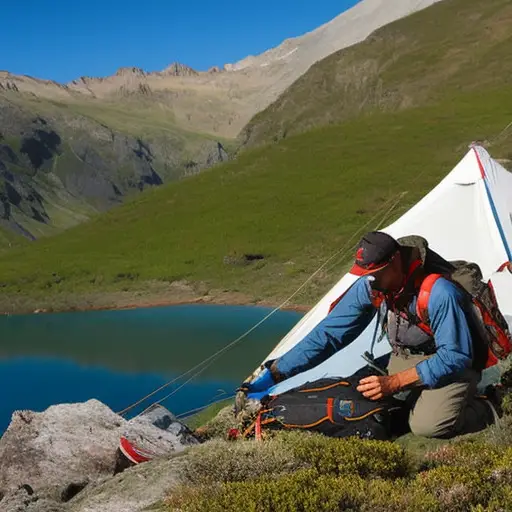Crafting Improvised Snowshoes for Winter Survival

In the treacherous winter wilderness, the ability to navigate through deep snow can be the difference between life and death.
This article explores the art of crafting improvised snowshoes, a vital skill for winter survival.
By utilizing readily available materials and following simple construction techniques, you will be equipped with the necessary tools to traverse snowy terrain with ease.
Discover the secrets to creating efficient snowshoes and ensure your safety and success in the harshest of winter conditions.
The Importance of Snowshoes
Snowshoes are essential tools for traversing snowy terrain during winter survival situations. They provide numerous benefits for outdoor activities in snowy conditions. One of the main advantages of using snowshoes is that they distribute your weight over a larger surface area, preventing you from sinking into the deep snow. This makes it easier to walk or hike through snowy trails without exerting excessive energy.
Snowshoes also provide traction and stability on slippery surfaces, reducing the risk of falls and injuries. They feature crampons or metal teeth on the underside, which dig into the snow and provide grip. This makes them suitable for various terrains, including flat, hilly, and icy surfaces.
There are different types of snowshoes available, each designed for specific terrains and activities. For example, traditional snowshoes have a long and narrow shape, making them ideal for hiking and traveling in deep snow. On the other hand, recreational snowshoes are wider and shorter, offering better maneuverability in packed or groomed trails. Additionally, there are specialized snowshoes for running, mountaineering, and backcountry exploration.
Essential Materials for Crafting
When considering crafting improvised snowshoes for winter survival, it is essential to gather the necessary materials. While traditional snowshoes are made with wooden frames and rawhide lacing, there are alternative materials that can be utilized for DIY snowshoe modifications. These materials can make the crafting process easier and more accessible, especially in emergency situations where traditional materials may not be readily available.
Here is a table highlighting some alternative snowshoe materials and DIY modifications:
| Material | Description | Pros |
|---|---|---|
| PVC pipes | Lightweight and durable, easy to find and work with | Ideal for making frame and bindings |
| Nylon webbing | Strong and flexible, provides secure foot support | Suitable for creating bindings |
| Paracord | Strong and versatile, can be used for various purposes | Ideal for lacing and securing the snowshoes |
Using these alternative materials, you can modify and create improvised snowshoes that are tailored to your specific needs. Remember to consider factors such as weight, durability, and flexibility when choosing materials for your DIY snowshoes.
Step-by-Step Snowshoe Construction
To begin the process of constructing improvised snowshoes, it is necessary to gather the materials mentioned in the previous subtopic. Once you have gathered all the essential materials, follow these steps to create your own improvised snowshoes:
-
Frame Construction: Start by selecting two long, sturdy branches that are slightly curved. These will serve as the main framework for your snowshoes. Trim them to your desired length, keeping in mind that longer snowshoes provide better flotation in deep snow.
-
Webbing: Next, attach a strong, flexible material between the two branches to create the webbing of the snowshoes. Paracord, nylon straps, or even strips of fabric can be used as alternative snowshoe materials. Weave the material in a crisscross pattern, making sure to secure it tightly to the branches.
-
Bindings: Finally, attach the bindings to secure your feet to the snowshoes. You can use sturdy rope or straps, ensuring that they are adjustable and can be tightened securely around your boots.
By following these steps, you can create your own improvised snowshoes using basic materials found in the wilderness. Remember to experiment with different improvised snowshoe designs and alternative snowshoe materials to find what works best for your specific needs.
Stay safe and enjoy your winter adventures!
Tips for Proper Snowshoe Sizing
Proper snowshoe sizing is crucial for optimal performance and comfort in winter survival situations. When it comes to snowshoes, there are two main types: traditional and modern. Traditional snowshoes are usually made of wood and rawhide, while modern snowshoes are made of lightweight materials like aluminum and synthetic fabrics.
One of the most common snowshoe mistakes is wearing snowshoes that are too small. This can cause discomfort and instability, making it difficult to walk in deep snow. On the other hand, wearing snowshoes that are too large can result in a clumsy gait and decreased maneuverability.
To determine the correct size, consider your body weight and the terrain you will be traversing. As a general rule, heavier individuals or those carrying heavy loads should opt for larger snowshoes. Additionally, the type of snow you’ll encounter – whether it’s light and powdery or wet and compact – should also be taken into account.
When comparing traditional and modern snowshoes, the sizing process remains similar. However, modern snowshoes often come with adjustable bindings and frames, allowing for more flexibility in fitting different foot sizes. Traditional snowshoes, on the other hand, may require additional modifications to ensure a proper fit.
Techniques for Securing the Bindings
Securing the bindings is a crucial step in ensuring the stability and functionality of your snowshoes during winter survival scenarios. Properly securing the bindings will prevent them from loosening or slipping, allowing you to navigate through the snow with ease. Here are three techniques to help you secure your snowshoe bindings effectively:
-
Different types of knots for securing snowshoe bindings: There are various knots you can use to secure your bindings tightly. The most common knot is the square knot, which involves crossing the ends of the binding and tying a simple knot. Another option is the bowline knot, which creates a loop that can be easily adjusted and tightened. Experiment with different knots to find the one that works best for you.
-
Alternative methods for securing bindings without traditional materials: If you find yourself without traditional binding materials, you can improvise by using natural materials such as vines, twigs, or sturdy plant fibers. These can be woven or tied together to create a secure binding system. Additionally, you can use duct tape or zip ties as temporary solutions until you find suitable materials.
-
Regularly check and readjust bindings: Snow conditions and usage can cause bindings to loosen over time. It is important to regularly check and readjust your bindings to maintain their secure position. This will ensure that your snowshoes stay firmly attached to your feet during your winter survival activities.
Testing and Adjusting Your Snowshoes
Testing and adjusting snowshoes is an essential step to ensure their functionality and reliability in winter survival situations. Before relying on improvised snowshoes, it is crucial to test them to identify any potential weaknesses and make necessary modifications. There are several testing methods that can be employed to assess the performance of your snowshoes.
One testing method is to take them out for a trial walk on different types of terrain, such as packed snow, deep snow, and icy surfaces. This will allow you to evaluate their grip, flotation, and stability. Pay attention to any discomfort or instability during the test walk, as this may indicate the need for adjustments.
Another testing method is to simulate a survival scenario by wearing a backpack with weights equivalent to the gear you would typically carry. This will help determine if the snowshoes can handle the added weight and provide sufficient support.
During testing, it is important to assess the bindings and make any necessary modifications. Ensure that the bindings are secure and provide a snug fit around your boots, as loose bindings can lead to instability and discomfort.
Frequently Asked Questions
How Long Can Improvised Snowshoes Typically Last Before Needing to Be Replaced?
The lifespan of improvised snowshoes varies depending on factors such as usage, terrain, and materials used. However, there are ways to maintain their durability and extend their lifespan, including proper maintenance, avoiding excessive strain, and using high-quality materials.
Are There Any Alternative Materials That Can Be Used for Crafting Improvised Snowshoes?
When it comes to crafting improvised snowshoes for winter survival, it is important to consider alternative materials. While traditional materials like wood and rawhide have their pros and cons, innovative options like aluminum and plastic offer durability and lightweight advantages.
Can Improvised Snowshoes Be Used in Other Terrains Besides Snowy Conditions?
Improvised snowshoes can be used in wet conditions to provide traction and prevent sinking. However, in sandy terrain, they may not be as effective due to the lack of solid ground.
Are There Any Specific Weight Limits or Restrictions for Using Improvised Snowshoes?
Weight limits and safety precautions should be considered when using improvised snowshoes. It is important to ensure that the materials used are sturdy enough to support the weight of the user and to take necessary precautions to prevent injury.
What Are Some Common Mistakes to Avoid When Constructing and Using Improvised Snowshoes?
When constructing improvised snowshoes, it is crucial to avoid common mistakes such as incorrect sizing and using weak materials. These errors can significantly impact the functionality and durability of the snowshoes.
Conclusion
In conclusion, crafting improvised snowshoes for winter survival is an essential skill that can greatly increase your chances of staying safe and mobile in snowy conditions.
By following the step-by-step construction process and ensuring proper sizing and secure bindings, you can create effective snowshoes using readily available materials.
These improvised snowshoes will allow you to traverse deep snow with ease and maintain your mobility in harsh winter environments, ensuring your survival in extreme conditions.





